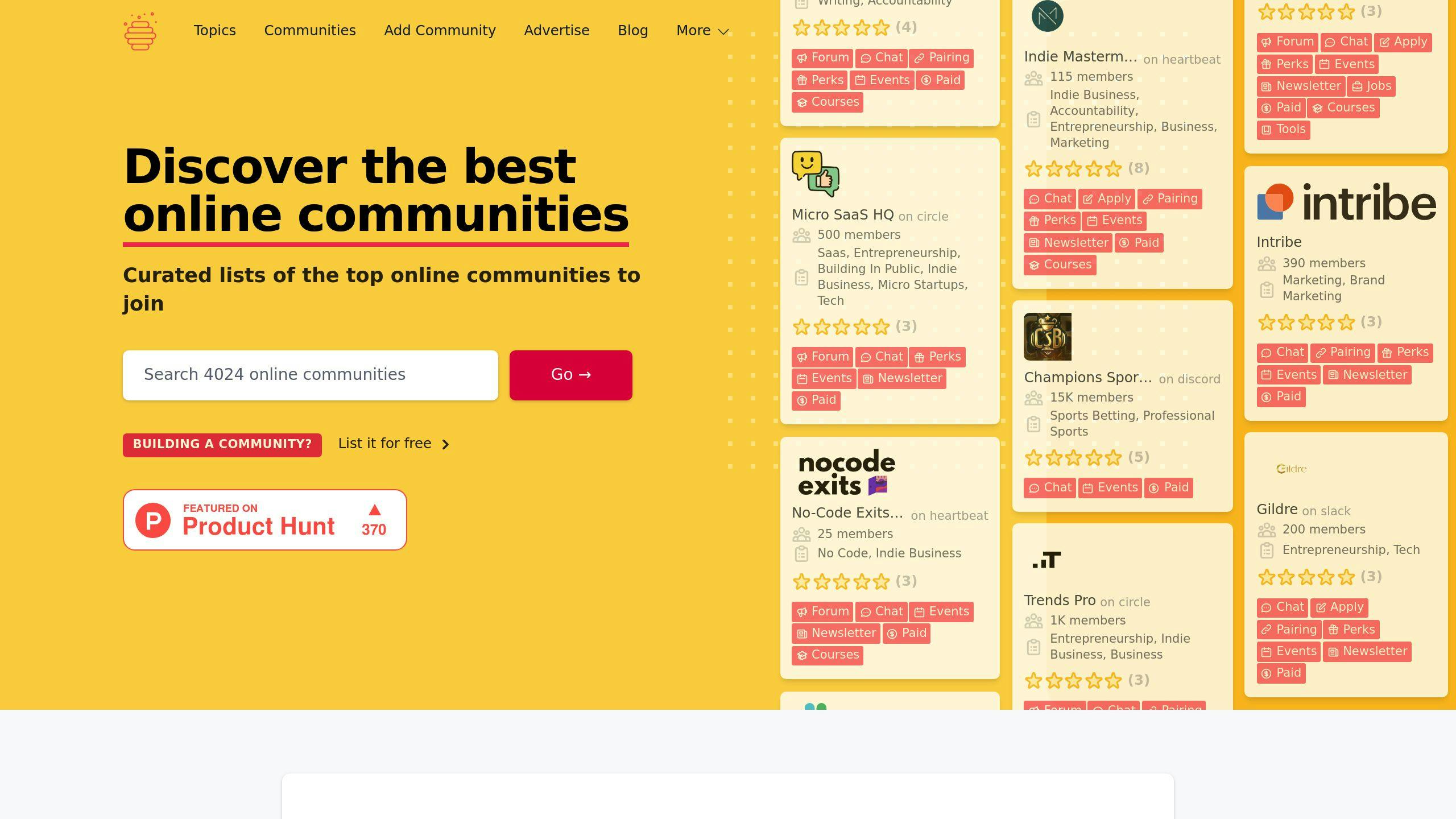Finding the right online community can help you grow professionally, learn new skills, and connect with people who share your interests. Here’s how to do it:
- Set Your Goals: Decide what you want – networking, learning, or pursuing hobbies.
- Search Platforms: Explore options like Discord, Slack, Facebook Groups, or Mighty Networks.
- Evaluate Culture: Check how members interact, the quality of discussions, and moderation rules.
- Engage Actively: Introduce yourself, participate regularly, and build genuine connections.
- Review Periodically: Assess if the community still aligns with your goals and adjust as needed.
Quick Comparison of Platforms:
| Platform | Best For | Features |
|---|---|---|
| Discord | Real-time discussions | Live chat, voice channels, less content organization |
| Slack | Business networking | Organized channels, integrations, can be costly |
| Facebook Groups | Hobby communities | Easy to join, limited control and privacy |
| Mighty Networks | Professional groups | Engagement tools, course creation, complex interface |
Start small, focus on meaningful participation, and adjust as your needs evolve. The right community can make a big difference in your journey.
1. Set Your Goals and Interests
1.1 Define Your Purpose
Start by figuring out why you want to join an online community. Here are some common reasons and what to look for:
| Purpose | What to Look For |
|---|---|
| Professional Networking | Groups focused on your industry or career topics |
| Skill Development | Communities sharing tutorials or offering mentorship |
| Hobby Sharing | Spaces for showcasing projects or discussing techniques |
| Support and Connection | Active, friendly discussions and a welcoming vibe |
Be clear about your goals. Instead of something vague like "learn about technology", try something specific, such as "master Python programming in three months" or "find UX designers for mentorship."
1.2 List Your Interests
Write down the topics that genuinely interest you. Begin with broad categories and narrow them into specific areas. Then rank them by priority.
For instance, if you’re into sustainable living, you might focus on:
- Renewable energy
- Zero-waste habits
- Eco-friendly products
- Sustainable food systems
To keep your goals realistic and achievable, try using the SMART framework:
- Specific: Focus on a clear goal, like mobile app development
- Measurable: Plan to finish three app projects
- Achievable: Dedicate five hours a week
- Relevant: Make sure it aligns with your career or personal growth
- Time-bound: Set a deadline, like six months
Stick to one or two communities to stay active and engaged. Once your goals and interests are sorted, you can start exploring platforms that match them.
2. Search for Platforms and Community Types
2.1 Explore Major Platforms
Once you’ve outlined your goals and interests, it’s time to dive into platforms that match your needs. Here’s a quick comparison of popular options:
| Platform | Ideal For | Features and Things to Keep in Mind |
|---|---|---|
| Discord | Real-time discussions | Offers live chat and voice channels but lacks advanced content organization. |
| Mighty Networks | Professional groups | Includes tools for engagement and course creation, though it can be more expensive and complex to use. |
| Slack | Business networking | Provides organized channels and integrations but can get pricey for larger communities. |
| Facebook Groups | Hobby communities | Easy to join with event features, but offers limited control and privacy. |
2.2 Use The Hive Index

The Hive Index is a helpful resource for discovering niche communities. You can search by topics, platforms, or specific features to find the right fit.
2.3 Understand Community Types
Identifying the type of community that suits your goals is just as important as choosing a platform. Here’s a breakdown:
| Community Type | What They Offer |
|---|---|
| Professional Networks | Industry discussions, job boards, and mentorship opportunities. |
| Learning Communities | Access to courses, workshops, and resource libraries. |
| Support Groups | Private discussions and moderated spaces for sharing. |
| Interest-Based Groups | Project showcases, meetups, and skill-sharing activities. |
For example, Discord’s massive user base (150 million users) makes it great for casual, real-time chats, while Mighty Networks is better suited for structured learning or professional groups [1][2].
Once you’ve narrowed down your options, the next step is to evaluate the culture and dynamics of these communities to ensure they align with your expectations.
3. Assess Community Culture and Dynamics
3.1 Watch Community Interactions
Spend some time observing how members engage with one another. Pay attention to these key areas:
| Interaction Element | What to Look For |
|---|---|
| Discussion Quality | Respectful exchanges, constructive feedback, helpful replies |
| Conflict Resolution | How disagreements are handled, and the moderators’ approach |
| Engagement and Support | Active involvement, sharing resources, collaborative efforts |
Monitor conversations over several days and at various times to get a well-rounded understanding of the community’s vibe and behavior patterns. This step ensures the community’s atmosphere aligns with your objectives and values.
3.2 Review Moderation and Rules
Strong moderation and clear rules are essential for a thriving community.
Clear Guidelines
Make sure the community has rules that are easy to find and understand. These should include:
- Standards for acceptable behavior
- Requirements for posting content
- Penalties for breaking rules
- Steps for reporting problems
Active Moderation
Look for communities where moderators are actively involved. They should:
- Address member concerns quickly
- Enforce rules consistently
- Communicate openly and transparently
Red Flags to Watch For
Be cautious if you notice any of the following issues:
- Rules are enforced inconsistently, or toxic behavior is ignored
- Lack of diversity or inclusiveness
- Constructive criticism is stifled
- Moderators are absent or unresponsive
Pay close attention to how problems are handled and whether they are resolved fairly and promptly. A well-run community should feel safe and welcoming, encouraging meaningful interactions among its members.
Once you’ve evaluated the culture and moderation, you’ll be ready to start engaging with the community.
sbb-itb-7c8e46f
4. Join and Engage in the Community
4.1 Make an Introduction
When joining a new community, start with a clear and concise introduction. Use your goals and interests to shape how you present yourself. Highlight key points that demonstrate your background and what you bring to the table:
| Element | Description |
|---|---|
| Background | Share your relevant experience or current role. |
| Purpose | Explain why you’re joining and what you aim to achieve. |
| Value Add | Highlight specific expertise or perspectives you can offer. |
| Interests | Mention the key topics you’re passionate about. |
Keep your introduction short and focused. Aim to connect with others in a meaningful way, avoiding oversharing personal details or coming across as overly self-promotional.
4.2 Participate Regularly
Being active in the community is essential for building relationships and working toward your goals, whether you’re looking to connect professionally or develop new skills. Regular participation helps establish trust and strengthens your presence.
How to Participate Effectively: Share your insights and engage in discussions where you have expertise or genuine interest. When responding to questions, take the time to provide thoughtful, helpful answers.
Managing Your Time: Create a routine that allows you to stay involved without feeling overwhelmed. Here’s an example schedule:
| Activity Type | Suggested Frequency |
|---|---|
| Quick Check-ins | Daily |
| Detailed Responses | 2-3 times per week |
| Content Sharing | Weekly |
| Event Participation | Monthly |
Building Connections That Matter: Focus on forming genuine relationships by contributing consistently and meaningfully:
- Ask thoughtful questions and share your experiences where relevant.
- Offer constructive feedback when it’s requested.
- Support others by engaging with their projects or ideas.
As you settle into the community, take time to periodically assess your involvement. Make sure the group continues to align with your goals and interests. Adjust your participation as needed to stay on track.
5. Review and Adjust Your Participation
5.1 Evaluate Your Experience
Take time every 3-6 months to reflect on whether the community is still meeting your expectations and goals.
Here are some areas to focus on:
| Evaluation Area | What to Look For |
|---|---|
| Engagement Quality | Are discussions engaging and constructive? |
| Content Relevance | Is the content useful and up-to-date? |
| Network Growth | Are you expanding your professional or personal network? |
| Time Investment | Does the time you spend match the value you get? |
Be alert for red flags, such as:
- Poor-quality or hostile discussions with little participation
- A shift in content or community culture that no longer aligns with your goals
- Inconsistent moderation or lack of inclusivity (refer to earlier moderation criteria)
If you notice these issues or feel the community no longer serves you, it might be time to look for spaces that better match your current priorities.
5.2 Explore Other Communities
If your review suggests your current community isn’t meeting your needs, consider exploring other options that might align better with your goals and interests.
Here’s a quick guide to different types of platforms:
| Platform Type | Best For | Key Features |
|---|---|---|
| Professional Networks | Career growth | Networking opportunities, job postings, skill-building resources |
| Interest-Based Forums | Hobbies and passions | Focused discussions, specialized resources |
| Learning Communities | Developing new skills | Access to courses and expert advice |
| Social Groups | Casual connections | Informal chats, events, and meetups |
When checking out new communities, compare their benefits with the goals you’ve previously outlined. Keep participating in your current community while gradually exploring others to avoid spreading yourself too thin.
Tips for managing multiple communities:
- Set aside specific times for participation to stay organized
- Monitor how much time you’re spending to prevent burnout
- Focus on meaningful engagement instead of trying to do it all
- Stick with communities that consistently add value to your life or goals
Connect and Thrive: The Ultimate Guide to Finding Your Online Tribe!
Conclusion: Start Your Journey to the Ideal Community
Finding the right online community requires focus and active involvement. As your goals shift, your ideal community might change too, so it’s important to stay open to new opportunities and connections.
To successfully find and join the right community, focus on these three steps:
- Define clear, actionable goals to understand what you’re looking for.
- Evaluate the community’s culture and fit to ensure it aligns with your needs.
- Commit to consistent and meaningful participation to build strong relationships.
Once you’ve clarified your goals, explored different platforms, and assessed potential communities, it’s time to take the leap – join and engage. This process isn’t just about signing up; it’s about discovering a space where you can grow and make a real impact.
Be patient and set realistic expectations. The most rewarding communities often reveal themselves through steady exploration and authentic interaction. Take the first step today and find a community where you can thrive and make a difference.
The Bee's Knees Newsletter
Subscribe to guest posts from community builders, entrepreneurs, and researchers, as well as new community launches and additional topics curated.
